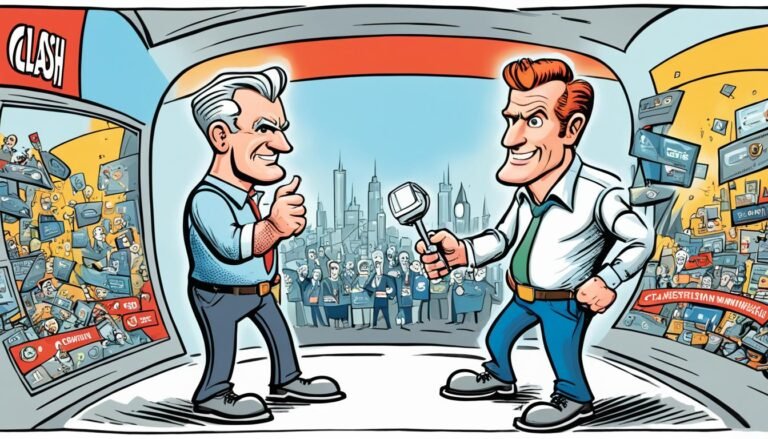Rosser Reeves: Defining the Unique Selling Proposition (USP) in Advertising
Imagine walking into a small, cozy café in New York City. The air is filled with the smell of fresh coffee and pastries. A barista greets customers by name, making the place stand out.
This scene shows how effective messaging can make a difference. It’s a perfect example of what Rosser Reeves called the Unique Selling Proposition (USP). He believed every ad must have a unique claim that others can’t match.
Reeves was born in Danville, Virginia, in 1910. He changed the advertising world with his idea. He worked at Ted Bates Inc. and wrote “Reality in Advertising,” which is in 28 languages.
His work helped Anacin sales jump from 18 million to 54 million. This shows the power of honest advertising.
Reeves’ ideas are still important today. Brands like Domino’s and FedEx used his USP ideas to win customers. They promised quick delivery and guaranteed results.
Let’s look at Rosser Reeves’ life and work. We’ll see how his ideas changed advertising and still shape marketing today.
The Life and Career of Rosser Reeves
Rosser Reeves was a key figure in modern marketing. He was born on September 10, 1910, in Danville, Virginia. Despite facing challenges early on, he turned his life around. He wrote a prize-winning essay that got him into the University of Virginia.
This success set the stage for a career that changed advertising.
Early Life and Education
Rosser Reeves grew up in a Methodist family. His early struggles didn’t stop him. He won a writing contest, which helped him get into the University of Virginia.
This was a big step in his career. It taught him the skills he needed for advertising.
Career Beginnings and Struggles
After college, Reeves turned to journalism for work. Then, he entered the advertising world. His early days were filled with challenges and learning.
He worked in different agencies, improving his understanding of what makes people buy things. Despite the tough times, Reeves kept pushing forward.
Rising in the Advertising Industry
Reeves made a big leap when he joined Ted Bates Inc. in 1940. He became a creative partner and used his knowledge of the ‘hard sell’ approach. This was inspired by Claude Hopkins’ “Scientific Advertising.”
He worked with big companies like Brown & Williamson Tobacco Company. His work during this time made him a top name in advertising.
| Years | Milestones |
|---|---|
| 1940-1965 | Creative Partner at Ted Bates Inc. |
| 1961 | Publication of “Reality in Advertising” |
| Retirement at age 55 | End of a prolific career |
The Concept of the Unique Selling Proposition (USP)
Rosser Reeves changed advertising with the Unique Selling Proposition (USP). This idea gives consumers a strong reason to pick one product over others. It’s based on Claude Hopkins’ “Scientific Advertising” ideas.
Definition and Origins
In the 1940s, Reeves came up with the term “unique selling proposition.” It’s about showing a clear, unique benefit in ads. This approach deeply affects consumer choices by offering a strong and different value.
The Three Core Principles of USP
Reeves’ USP idea has three main parts:
- The advertisement must present a concrete benefit: For example, Anacin in 1952 used “Fast, incredibly fast relief” to highlight its caffeine.
- The benefit must be exclusive to the brand: M&M’s 1954 USP, “Melts in your mouth, not in your hand,” was about a special sugar coating.
- It must be potent enough to attract a mass audience: Dominos Pizza’s “You get fresh, hot pizza delivered to your door in 30 minutes or less—or it’s free” from 1973 to 1993 is a great example.
Impact on Advertising Strategy
The USP framework is key to a company’s marketing strategy. It boils down the main value of a product into one clear, memorable benefit. This approach deeply connects with consumers.
Companies need to deeply understand their audience and match their brand with those needs. They should avoid tricks and focus on real benefits. Metropolitan Life’s “Get Met. It Pays” in 1984 showed how a strong USP can highlight benefits like more coverage and cash value.
Finding a USP can be hard, especially keeping it unique and adapting to market changes. But, a well-done USP can greatly improve a brand’s competitive edge.
Examples of Successful USP Campaigns
Rosser Reeves’ theory of the Unique Selling Proposition (USP) has helped many companies stand out. It shows how a strong USP can lead to memorable slogans and growth for brands.
Domino’s Pizza
Domino’s Pizza is a great example of how a USP can lead to success. They promised “Hot, fresh pizza delivered in 30 minutes or less, guaranteed.” This caught the attention of consumers and helped Domino’s grow in the market.
This simple yet powerful USP made Domino’s stand out from others. It shows how clear messaging in ads can make a big difference.
FedEx
FedEx is another great example. They used the USP of guaranteed overnight delivery with the slogan, “When it absolutely, positively has to be there overnight.” This made FedEx the go-to for urgent shipping needs.
Their promise was clear and specific. It told consumers they could rely on FedEx for fast and reliable service.
M&M’s
M&M’s also saw big benefits from the USP. Their tagline “It melts in your mouth, not in your hands” highlighted a unique feature. This made M&M’s stand out in the candy market.
This promise not only pointed out a benefit but also made the brand unique. It shows how the right messaging can lead to brand success.
Rosser Reeves’ Influence on Modern Advertising
Rosser Reeves changed modern advertising forever. He introduced the Unique Selling Proposition (USP) at Ted Bates & Company in the early 1940s. This idea helped brands stand out in crowded markets. Reeves believed in clear messages over creative ideas, shaping many marketing strategies today.
Influence on Marketing Strategies
Reeves said a marketing campaign must have a unique and compelling proposition to draw in new customers. This idea is still key to successful marketing. By focusing on real benefits, marketers today connect with consumers on a deeper level. Companies like General Electric and Oral-B have thrived by offering unique services.
Continuous Legacy in Advertising
Reeves’ ideas from “Reality in Advertising” have made a lasting impact. Published in 1961, it’s been translated into twenty-eight languages. It’s seen as a must-read for advertising pros. Reeves taught the importance of strong, compelling propositions, ensuring his legacy continues.
Today, leading companies focus on differentiation to stand out. Reeves’ teachings show that a focused, USP-driven approach attracts customers and builds loyalty.
Criticisms and Controversies
Rosser Reeves has made a big impact, but his methods have faced a lot of criticism. His advertising style was often seen as too aggressive and questionable. This part looks into the main criticisms and how they changed views on ethical advertising.
The Rosser Reeves Fallacy
The term “Rosser Reeves Fallacy” was coined to point out a big mistake. It’s the idea that just being well-known through ads means you’ll always do well. Critics say Reeves’ hard-sell tactics ignored the need for real customer connection and loyalty.
His ads, like the Anacin commercial that ran for seven years and boosted sales, worked well at first. But they didn’t build a lasting brand. This shows the shortfalls of Reeves’ approach.
Ethically Questionable Tactics
Reeves was also hit for using tactics that some found unethical. His focus on making sales often clashed with what’s right in advertising. His use of repetitive, persuasive ads was seen as more about tricking people than telling the truth.
This sparked debates on the importance of honesty and openness in ads. It made people call for stricter rules in the industry.
Rosser Reeves: Defining the Unique Selling Proposition (USP) in Advertising
In the early 1960s, advertising was looking for a new way to stand out. Rosser Reeves came up with the idea of a Unique Selling Proposition (USP). He believed that every ad should offer something unique and appealing to attract new customers.
Reeves and his agency, Ted Bates & Company, led this advertising revolution. They used the USP to boost their earnings from $4 million to $150 million (about $1.2 billion today). They focused on two key measures: Penetration and Usage Pull. Penetration showed how many people remembered the ad, and Usage Pull measured how many were drawn to the product.
Reeves shared three ways to create a strong USP: find the USP in the product, change the product to have a USP, or highlight what’s new about it. He also warned against changing ads too often, stressing the need for consistency.
For Reeves, the USP was more than a marketing term; it was a key strategy. A clear USP helps customers see why they should choose a product over others. It combines uniqueness, selling power, and proposition to make a strong message that attracts customers and boosts sales.
Having a consistent message and campaign has proven successful, as seen with Gary Vaynerchuk’s growth from a $3 million wine business to a $60 million empire. Reeves also showed the USP’s power through product tests and market surveys at Ted Bates & Co.
Today, the USP is still crucial for branding and marketing. Possible USPs include unique designs, advanced technology, special materials, or country of origin labels. A clear USP guides product development and marketing, focusing on unique benefits to convince customers of the product’s value.
Real-World Applications of USP
Rosser Reeves introduced the Unique Selling Proposition (USP) in the 1940s. This changed the way ads worked, focusing on one main message. USPs help brands stand out by showing what makes them different from others. This idea is still key in today’s digital world, especially in social media and brand identity.
Modern Marketing Examples
Many brands today use USP to be noticed. Uber changed the taxi industry by connecting riders with drivers online for a better experience. Slack made teamwork easier with simple tools, aiming to make people less busy and more productive.
USPs speak to people by focusing on benefits, not just features. They guide a company’s growth and are often made with help from specialist agencies. This ensures they fit the target market well.
Adapting USP to Social Media
Now, making a USP work on social media is crucial. Social media lets companies share clear, strong messages with their audience. SEO has changed, now focusing on unique traits that help brands stand out online.
To make a USP work on social media, companies should:
- Identify their unique strengths: Know what makes them different.
- Understand customer needs: Talk to customers in a way that connects.
- Distill the message: Make the USP clear in one sentence.
An effective USP should also be ready for the future, showing what makes a brand different over time. Lucky Strike’s “It’s Toasted” ads showed their USP everywhere, keeping their brand clear.
| Brands | USP | Impact |
|---|---|---|
| Uber | Smart connections between passengers and drivers | Revamped transportation industry |
| Slack | Streamline teamwork with ease | Enhanced productivity in the workplace |
| Lucky Strike | It’s toasted | Strong, timeless brand positioning |
Using USP in modern marketing on platforms like Facebook, Twitter, and Instagram helps brands reach more people. Being at the top of Google search gets a lot more clicks. This shows how important clear USPs are for grabbing attention. It boosts website visits, landing pages, and helps build a unique brand personality.
The Evolution of Advertising Techniques
Advertising has changed a lot over the years. It used to be all about a hard sell, like Rosser Reeves’ Unique Selling Proposition (USP) in the 1940s. Now, we use inbound marketing, which focuses on giving value and building relationships with customers. This approach attracts people by offering useful content and engaging with them, not just pushing sales.
From Hard Sell to Inbound Marketing
Reeves brought the USP to the scene in the 1940s. His method was all about clear messages to get customers to act fast. This hard sell was the norm until the early 1960s. Now, we’re into inbound marketing, which is all about building relationships with customers over time through interesting content.
Companies use blogs, social media, and emails to draw in and turn leads into customers. They work with a smarter, more choosy audience.
Integrating USP with Emotional Branding
Today’s ads need to be more than just about benefits. They need to connect with people on an emotional level. This means being real and personal, which is what today’s consumers look for in brands. Brands like Uber and Slack do this well by combining their unique offers with emotional stories.
This approach makes their message strong and memorable. Reeves’ ideas are still important, but they’ve evolved. Using emotional branding and inbound marketing shows how his ideas are still relevant today.
Source Links
- Rosser Reeves and his Unique Selling Proposition
- 10 Lessons of Advertising From Rosser Reeves | Marketing Strategy
- Back to the future: Rosser Reeves’ legacy | WARC
- Rosser Reeves
- Learning from Mad Men – using a USP in advertising
- Unique selling proposition
- What is Unique Selling Proposition (USP)? USP Definition
- Brand History: Unique Selling Proposition (USP) – Michael Kraabel
- Unique selling proposition
- Project MUSE – Excerpts from Reality in Advertising
- The Brand Differentiation Mandate – Branding Strategy Insider
- Unique Selling Proposition: The Ultimate Guide – SM Insight
- Unique Selling Proposition: Defined
- Microsoft Word – Proceedings 4.25.07.doc
- Book Summary: Reality In Advertising by Rosser Reeves
- Unique Selling Proposition (USP): Product Management & Operations Explained
- Unique Selling Point – Ryte Wiki
- What is a Unique Selling Proposition? Definition, Examples & FAQ | airfocus
- How to Develop a Unique Selling Proposition – Invesp
- What Is a Unique Selling Proposition?
- What Is Your Business’s Unique Selling Proposition?







